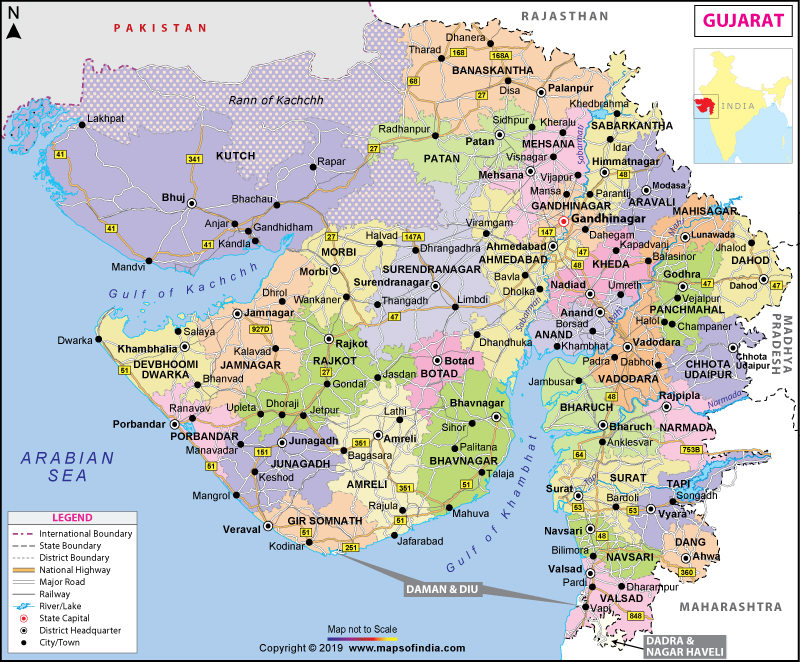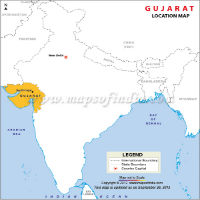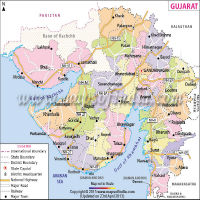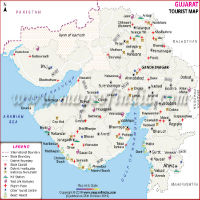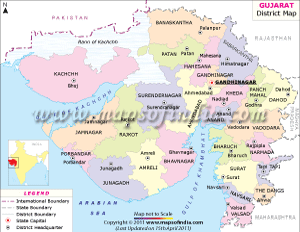About Gujarat
Gujarat or "the land of the legends" is one of the most important states situated in the western part of the country. Geographically bordered by the vast Arabian Sea and Pakistani province of Sindh on the west, Rajasthan on the north, Maharashtra with Diu, Dadra, Daman union territories on the south and Madhya Pradesh on the east, Gujarat stand unique in its topographical as well as geographical landscape. Gandhinagar is the capital and Ahmedabad is the most important city in the state.
The total area of Gujarat is roughly around 196,024km2 and the total population of the state stands out to be 6,04,39,692 as per the census of 2011. Being the birthplace of many Indian legends like Mahatma Gandhi and Vallabhbhai Patel, this place has a rich heritage of culture and traditions which glorifies the state. Summers are dry and hot whereas winters are mild and pleasant. Monsoon usually drenches the southern part of the state whereas the North West remains dry throughout the year. Gujarat is ideal for educational tourism since one can get to learn different cultural traits of India here. The government of Gujarat is very active and there are around 182 seats for the legislative assembly. Earlier, Gujarat was under the Bombay state (present day Maharashtra and Gujarat, but it was separated as an individual state in 1960.
| Facts on Gujarat | |
|---|---|
| Official Website | www.gujaratindia.com |
| Date of Formation | May 1, 1960 |
| Area | 1,96,244 km2 |
| Density | 308/Km2 |
| Population (2011) | 6,04,39,692 |
| Males Population (2011) | 3,14,91,260 |
| Females Population (2011) | 2,89,48,432 |
| No. of District | 33 |
| Capital | Gandhinagar |
| Rivers | Sabarmati, Mahi, Narmada, Tapti, Saraswati, Damanganga |
| Forests & National Park | Gir NP, Wild Ass Sanctuary, Nal Sarovar Bird Sanctuary, Blackbuck National Park, Velavadar, Vansda NP |
| Languages | English, Gujarati, Sindhi, Marwari, Kutchi, Urdu, Hindi, Sourashtra, Vasavi |
| Neighbours State | Madhya Pradesh, Maharashtra, Rajasthan, Daman and Diu, Dadra and Nagar Haveli |
| State Animal | Asiatic Lion |
| State Bird | Greater Flamingo |
| State Tree | Mango |
| State Flower | Marigold (Galgota) |
| Net State Domestic Product (2011) | 75115 |
| Literacy Rate (2011) | 76.64% |
| Females per 1000 males | 918 |
| Assembly constituency | 182 |
| Parliamentary constituency | 26 |
History of Gujarat
The history of Gujarat can be divided into ancient, medieval and modern subcategories. The ancient history can be associated with the Indus Valley Civilization. The first people who had settled in Gujarat were the Gujjars, who were from Afghanistan and Pakistan. Then came the Maurya dynasty when the ruler Chandragupta Maurya and his grandson, King Asoka, established their supremacy over the region. After his death, several dynasties like the Shungas, the Sakas, the maitrakas, the Chawura, the Solankis', and the Baghilah, etc ruled Gujarat before the Muslims invaded the area and ruled there for around 400 years. Starting from Mahmud of Ghazni to Allaudin Khilji to King Akbar, all had conquered Gujarat with valor but soon the Muslims were expelled out by the Maratha king Shivaji. In the 17th century, with the advent of the British the Maratha power was dominated and the state was divided into several princely states like Ahmedabad, Bharuch, Panch Mahals, Kaira, and Surat which were then ruled by them. When India was struggling for Independence, Gujarat became a hub of freedom fighters, all natives from the place. Post-Independence, Gujarat was a part of the Bombay state ruled by Indian National Congress. It was only in 1960 that Bombay state was split into Maharashtra and Gujarat and the state was given a separate identity of its own.
more...
Geography and Climate
Being situated on the western coast of the peninsula of India, the coastline is the third longest in the country with a stretch of around 1300 kms. There are three geographical subdivisions in the state: the barren as well as rocky Kutch in the north east, comprising the famous Rann or desert of Kutch, the hilly region composed of small mountains known as the Saurashtra and the Kathiawar. The main land starts from the Kutch to the river Damanganga and is filled with plain alluvial soil. There are few rivers like Sabarmati, Narmada, Tapi, and Damanganga that flow through the state of Gujarat. The northern and the eastern parts of the state are bordered by the mountain ranges like the Aravalli, Satpuras, Vindhya and the Sahyadris. A significant part of the state is covered by the forests and the Gir, PanchMahals and the Dang areas are well known for the same. these forests comprises of both moist as well dry deciduous vegetation. Some of them are thorny, mainly near the Kutch area. The climate of southern Gujarat is moist whereas it is dry in the northern part. Rainfall averages between 33 to 152 cm annually where as certain areas like Dang accounts a rainfall of 190 cm. Being located on the Tropic of Cancer, the extremity of the climatic conditions are smoothened by the Gulf of Cambay and the Arabian Sea. more...
Tourism
Gujarat is known as the "jewel of the west" and with a wide range of museums, forts, sanctuaries, temples, and other places of interest, tourism in Gujarat can be a treat for the tourists. Since the place has profound historical aspect, several historical places are there to visit there, like the Hriday Kunj, or the residence of Mahatma Gandhi, the Lothals or the remnants of Indus Valley civilization, Kirti Mandir or the birth place of Mahatma, Vadnagar which is famous for Hatkeshwar temple and torans, Dholavira and many more.
Tourists may also like religious places like Dwarka, Pavagarh, Somnath, Shamlaji, Jain temples at the Palitana Hills and the Girnar Hills. Interested people may also go to witness the wonderful architecture and archaeological monuments of Ahmedabad, Patan, Dabloi, Modhera, etc. The hill resort of the Satpura happens to be the destination of many tourists and they also love to hit the beaches in Corwad, Tithal and Mandvi. Apart from these, the Gir lion sanctuary and the sanctuary in Kutch are also the top favorite destinations for nature lovers. Other than these, there are several forts like the Uparkot Fort, Nazar Bagh Palace, Dabhoi fort, etc and museums like the Gandhi Smarak Sanghrahalaya, Gandhi museum, and the Baroda Museum and Picture Gallery that are also visited by thousands of tourists every year. more...
Government and Politics
There are 26 districts in the state of Gujarat, with Gandhinagar being the political hub. The government of Gujarat has a legislative assembly comprising of 182 members out of which 39 seats are reserved for schedule castes and schedule tribes. Like all other Indian states, the chief minister is the leader of the government as well as the Legislative assembly and has some exclusive executive powers. The governor, elected by the president of India is the head of the state and the speaker, elected by the legislative assembly, presides over the meetings of the Assembly. Post-Independence till the state of Gujarat was separated from the state of Bombay, Indian National Congress were the undisputed leaders of the government and politics of the state. It was in the mid 90's assembly polls that the party lost to BJP, who are still in power in the state. In spite of several political and communal riots in the state, the BJP government has been able to keep its supremacy over the state for the past several years. more...
Education
Gujarat happens to be the home of some of the most well known and prestigious educational institutions in the country. The state pays attention in order to improve the basic education and has launched several primary schools as well as education programs free of cost for all the kids of the state. Several private and government schools for secondary standards are there in the state affiliated to the CBSE or the CISCE boards. Women's education is taken care of with special attention. For higher education, there are several universities like the Gujarat University, the Saurashtra University, Hemchandracharya North Gujarat University, etc are few of the top state universities in Gujarat. IIM, Ahmedabad, The Maharaja Sayajirao University of Baroda, the Sardar Vallabhbhai Patel Institute of Technology, Surat as well as the National Institute of Design, Ahmedabad are a few famous educational institutes well known all across the country. There are several engineering colleges in the state, and some of them like the Sardar Vallabhbhai Patel Institute of Technology and the Dhirubhai Ambani Institute of Information and Communication Technology rank top in India. Few other institutes like the Central Salt and Marine Chemicals Research Institute is a reputed institute in Gujarat that encourages various research works mainly on marine salt, inland lake salt, and sub-soil brine.
Economy
In Gujarat, major industries are manufacture of textiles, chemicals, electrical engineering, pharmaceuticals, food processing industry, vegetable oils, soda ash and fertilisers. Being a mineral-rich state, Gujarat produces 66% of the salt required by the nation and 35% of the chemical requirement gets fulfilled from the state. Ankleshwar and Khambat are well known for natural gas and oil production. Rajkot is the hub for engineering manufacturing with industries for auto engines, auto components, CNC machines, forging and casting parts. Gujarat is well known for manufacturing and trading gems and jewellery. Surat is well known for diamond trade. The state is also the main producer of cotton, tobacco, rice, groundnut, wheat, bajra, jowar, maize gram and thus the economy of the state is mainly agricultural. Dairying and animal husbandry is also a source of rural economy for the state. It is also the largest producers of milk in India as well as in Asia, through the Amul milk co-operative federation. The state is also a major producer of livestock, eggs and wool apart from oil, soaps and petrol. Tourism is also a fine source of economy for the state. The largest ship breaking yard of the world is at Bhavnagar, and Reliance petroleum, a part of the Reliance Industries Ltd. is located at Jamnagar which is the largest grass root refinery in the world.more...
Demographics
As per the census of 2011, the total population of Gujarat state is 6,04,39,692 and the population density is calculated to be roughly 308 per km square, which is lower in comparison to the others. The ratio of male and females are decent, with 918 girls per 1000 boys, which again one of the lowest among all others. Hinduism is the main religion of Gujarat, forming 89% of the total population. Lord Krishna is the main deity worshipped in the state in his form of Srinath. Muslims form the next major chunk of population, forming 9.1% whereas the Jains and the Sikhs and the Christians form the rest. A majority of the Hindu population of the place comprises of the Gujaratis who are quite vibrant and cordial in nature. The Marwaris and the Biharis form large communities residing in Gujarat. A small portion of Portugese people reside in Ahmedabad. Among the other people staying in the state of Gujarat, there are Indian communities of Tamils, Telegus, Malayalis, Konkanis, Punjabis, Sindhis, Tibetans, Nepalis, Oriyas, Assamese, Bengalis as well as foreign communities like the Parsis, Jews, South Koreans, Anglo-Indians and Greeks
Culture
Having a wide range of cultural diversities, Gujarat is a considered to be flourishing and vibrant with a rich cultural heritage and traditions. The state is known as the land of festivals and fairs. Other than traditional Indian festivals like Holi, Diwali, Dussera, the other Hindu festivals are widely celebrated here like the Makar Sankranti or kite flying festival, Modhera, Kutch Mahotsav and the Bhadra Purnima. Other festivals like Eid, Christmas and Mahavir Jayanti are also celebrated in the state with equal enthusiasm. Dance and music are integral part of the festivals and special occasions. Dance forms of dandiya raas, garba, garbi and padhar are famous worldwide. Folk songs and classical music are practiced regularly by locals as well as veteran musicians and several ragas have originated from the state like Khambavati, Lati, Todi, Sorathi, etc.
Handicrafts in the state are a blend of modern as well ancient influence and exhibit artistic yet aesthetic elements in them. Embroidery, wood carving printing, jewellery as well as stone work are popular all around the world and represent the sheer culture of the state. Patola silk and the Surat zari materials for sarees are widely popular all across. Certain special varieties of embroidery which are special in Gujarat are the Salama, Chalak, Tiki and Kangiri. Abhala craft is the famous mirror work in the state where small mirrors are woven on the fabric giving a glittering effect to the embroidery.
Food
Gujarati cuisine is influenced of Jain culture and hence it is predominantly vegetarian. However, some communities do indulge in non-vegetarian food. Some of the special Gujarati cuisines are:
- Gujarati Thali
- Rotlo (Gujarati homemade breads)
- Dal (Pulses)
- Farsan
- Khandvi
- Undhiyu
- Gujarati Kadhi
- Dhokla
- Bardoli ki Khichdi
- Methi ka Thepla
- Dal Dhokli
- Handvo
- Fafda
Language
The inhabitants of Gujarat belong to different castes, communities and religions. Hence, there are several languages that are widely spoke in the state apart from the main official language, Gujarati. The language is derived from the Indo-Aryan family, just like most of the other languages of India and has its roots in Sanskrit. Gujarati has around 11 dialects which are spoken by different people belonging to different regions of the state. Some of them are the standard Gujarati, Gamthi, Kathiwadi, Kharva, Khakari and Parsi dialects among others. Parsi Gujarati is very sweet to listen to and are mainly used by the native Zoroastrians. It is, however, different from original Gujarati and has quite a few Persian words in them, which are used by people while speaking as well as writing. Since the state shares common borders with others like Rajasthan. Maharashtra and Madhya Pradesh, people staying near those border regions speak in their respective languages. Marwari, Marathi and Hindi are also widely spoken languages in the state, for obvious reasons. Sindhi and Urdu are spoken by a section of population. Kutch, which is an important area of the state, has a different mother tongue, known as Kachchi and is popular among the inhabitants of the place. It is considered to be a mixture of Sindhi and Gujarati
Tourism
Gujarat is one of the tourist paradise. It has long white desert, longest coastlines, beautiful temples, Asiatic lions, Buddhist caves to name a few. Some of the popular tourist places in Gujarat are:
- Gir
- Somnath Temple
- Rann of Kutch
- Ahmedabad
- Saputara
- Laxmi Vilas Palace
- Dwarka
- Rani ki Vav, Patan
- Lothal
- Bhuj
- Junagadh
- Champaner-Pavagadh Park
- Surat
- Diu
- Dholavira
- Rajkot
